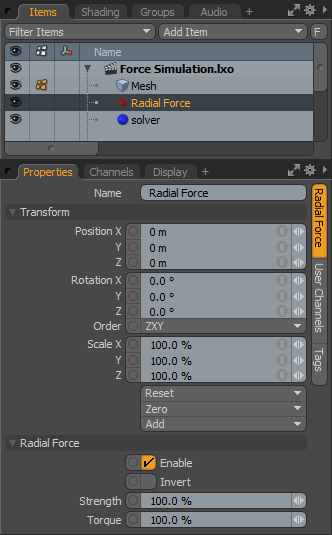
The radial force item applies a force that draws items toward or pushes them away from the force locator center (defined by the item's position).
This force is like a magnet that repels or attracts dynamic objects. The higher the positive value, the stronger the push force applied, the greater the negative value, the stronger the attraction.
You can add a radial force item to a simulation by selecting Forces > Radial in the Layout interface's toolbox. Alternatively, in the Items list, click Add Item > Forces > Radial Force. Any force added after a dynamic body auto-connects to the solver item, forces added beforehand need to be connected manually in the Schematic view.
Remove force items the same way as any other item: simply select the item and press Delete on the keyboard.
When selected, the following attributes appear in the Properties viewport.

|
Option |
Description |
|---|---|
|
Name |
Displays the current force item name. To change it, click on the field and type in the new name. |
|
Transform |
|
|
Position X/Y/Z |
An item transform that allows you to numerically position the force item in XYZ space, representing the point of the repulsion or attraction. |
|
Rotation X/Y/Z |
The radial force item affects items radially, therefore these values are not applicable to it. |
|
Scale X/Y/Z |
The radial force item globally affects dynamic items regardless of its scale, therefore these values are not applicable to it. |
|
Radial Force |
|
|
Enable |
Toggles the force item on or off. When enabled, the force item is considered during a dynamics simulation; when disabled, the force item is ignored. However, disabled forces are persistent across Modo sessions, being saved with the scene, and retain their present settings. |
|
Invert |
Reverses the pull direction of the radial force. |
|
Strength |
Determines how powerful the force is pulling or repelling. The higher the value, the greater the influence of the force. Negative values push dynamic items away, and positive ones pull them toward the radial force. |
|
Torque |
Acts as a multiplier on rotational movements of dynamic items. The higher the value the greater the strength of the force. |